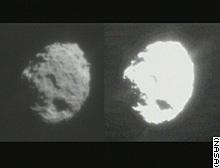The collected particles may reveal the secrets of the universe
Avi Blizovsky

After traveling for four years and more than 3 billion kilometers, NASA's high-speed spacecraft managed to reach the glittering tail of a comet on Friday, collect dust samples from it and send back rare photographs of a celestial body from only 230 kilometers away.
Shortly after 21:45 last Friday, Israel time, the Stardust spacecraft arrived at the closest point to the massive block of rock and ice known as Comet Wild-2, approaching a distance of 230-250 kilometers from it, at a speed of nearly 22 km. That.
At this point the spacecraft made a turn, pointed its camera at the comet's nucleus and took pictures that began to reach Earth an hour later. The spacecraft also reported that its tennis racket-like robotic arm captured dust using a material called aerogel.
"We were able to successfully collect samples from the comet and now we are bringing them home for analysis in laboratories all over the world" says Don Brownlee of the University of Washington, the lead researcher on the Stardust mission, a mission that cost 200 million dollars.
While the particles collected in space will take two years to reach Earth, the scientists said the dust counter will begin broadcasting its findings on the size and number of the particles immediately to Earth. Another gadget is planned to analyze and report on the composition of the material, and the researchers hope to receive many black-and-white images of the comet's icy core in the coming days.
But the biggest promise is together with the dust on board the spacecraft. If it brings the samples back, the mission will be the first robotic mission to bring back material from space since 1976, when the Soviet spacecraft Luna 24 brought back rocks and stones from the moon.
The hope is that the comet dust, which has resided in the cold of space for billions of years, can provide clues to the question of how the solar system was formed, including the sun and the planets, and perhaps also how other stars and the entire universe were formed.
In recent decades, several spacecraft have passed close to comets and provided us with excellent data," said Brownlee. "StarDats marks the first time we have ever collected samples from a comet for the purpose of bringing them to Earth for research.
Survival of a spaceship 300 million kilometers from Earth is not an easy thing. The scientists made the tool the size of a refrigerator to crash into rocks and the other fragments fly at them at 6 times the speed of a rifle bullet. The spaceship was protected by two bumpers in front, which protected its solar collectors and another shield that protected the body of the spaceship.
"We flew through the most dangerous area and we are still in contact with the spacecraft," said Tom Duxbury, Saturndust program manager. "We can now breathe more easily." he said, as he clicked with his fellow scientists at NASA's Jet Propulsion Laboratory in Pasadena, California.
After collecting the particles, the arm that collected them was meant to fold into a capsule, designed to close like a clam for return to Earth.
In January 2006, the capsule is scheduled to separate from the spacecraft and make a soft landing in the Utah desert, while the mother ship, Stardust, will remain in the spacecraft. Inside the capsule will also be particles collected in the months of February to May 2000, when the spacecraft passed through an area where interstellar dust particles flow in the solar system.
The science that came out of all this will tell us about the first period, the period of creation of the solar system, the role of comets in the creation of the earth and the life on it. All of these will be revealed over the next few years," Duxbury said. "The science this project will provide is invaluable."
The researchers hope that the physical and chemical information contained in the comet dust samples, which can barely fit into a thimble, will teach them whether the comets or the interstellar dust contain water or organic substances essential for the creation of life.
Comets, probably the oldest bodies in the Solar System, can hold records of the original material that formed the Sun and planets 4.5 billion years ago. Interstellar particles, also collected by the Stardust mission, contain most of the important as well as complex carbon structures. The initial origin of these carbon compounds is still a mystery, but scientists believe they are related to young stars.
"We collect things that are very old and even older than our solar system." Brownlee said. "We are literally reaching for the stars."
